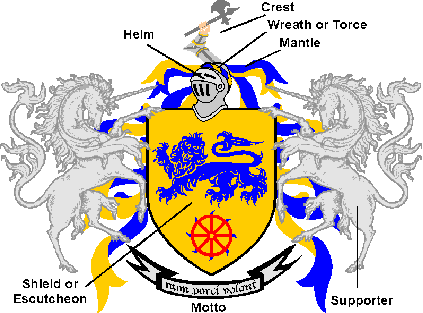Bray Wanderers' badge

Properly termed an escutcheon, the badge used by the club is based on that of the town, with differences in the colour and design, and without the motto. It shouldn't be called a crest (that's the bit on top of the helmet above the shield in a full coat of arms, or 'hatchment': there's an example at the bottom of the page).
These changes, while leaving it recognisably in the direct Bray tradition, make it distinctly its own identity.
The correct heraldic description of the escutcheon, its blazon, is as follows:
Vert, in chief of a chevron rompu argent a martlet of the field, in dexter chief a bell of the second, in sinister chief a lion passant of the same, in middle base a mermaid erect with comb and mirror all of the same
Compare the blazon of the town arms and both the differences and the similarities can be seen:
Party per chevron rompu gules and azure, in chief of a chevron rompu or a martlet sable, in dexter chief a bell of the third, in sinister chief a lion passant of the third, in middle base a mermaid erect with comb and mirror proper; motto 'FÉILE AGUS FÁILTE'

The arms adopted by Bray UDC
The arms of the town of Bray were devised to suggest topographical features and to commemorate local history. The chevron in the shield represents the bridge over the Dargle river which separates Little Bray from rest of the town. On one side above the chevron is a bell, which represents the ruined church of 13th century origin known as Raheenacluig (Ráithín an Chloig, a name which suggests an earth-roofed chapel, with a bell), now on the golf course at Bray Head: Coláiste Ráithín, based in the old 'Bray Tech' (the Vocational School) on the Florence road, is named after it.

The arms of the O'Tooles
On the other side is a lion, taken from the arms of the O'Tooles, a family which had a castle at Powerscourt and which has been prominent in the Bray district since early times.
On the raised, or 'broken' centre of the chevron is a martlet, often called a heraldic swallow, which signifies the long and close association of the family of Brabazon, Earls of Meath, with the civic life of Bray.

The arms of the Brabazon family
The martlet is an oddity in that it was believed to have no feet, and consequently was in perpetual motion. Its name comes from the same source as that of the (house or sand) martin. It is also used as a 'difference' in the arms of large families, indicating the arms of a fourth son.
It is found in the McGill and McCoy arms, too.
The arms of the O'Byrnes
In the lower part of the shield is a mermaid, derived from the arms of the O'Byrnes, another family which is closely associated with Bray and which took a very active part in the wars of the sixteenth century. The mermaid is the crest in the O'Byrne arms, right at the top. Click on the picture to see a larger version!
The Bray motto "Féile agus Fáilte" means "Hospitality and Welcome". While the Club's name in the scroll below the shield looks like a motto, it would not be included in the blazon, any more than the family name 'Brabazon' in the example above would be.
Although there is evidence of human habitation from pre-historic and early Christian times in the area, the first permanent settlement came at the time of the Norman invasion, when the manor of Bré was granted in 1173 AD to Walter de Riddlesford who built a castle on a site overlooking the river where St. Paul's Church now stands.
The settlement was constantly attacked over the centuries by the O'Tooles and O'Byrnes, who had their strongholds in the mountains above the town. During the reign of Henry VIII the manor was given to the Brabazon family, ancestors of the present Earl of Meath who lives in Kilruddery House, south of the town. That house has been in the Brabazon family since it was built in 1618; it was substantially reconstructed in the 1820s.

An example of a full coat of arms, or hatchment (from the French 'achèvement'), with its main parts identified
hatchment courtesy thinkquest.org

